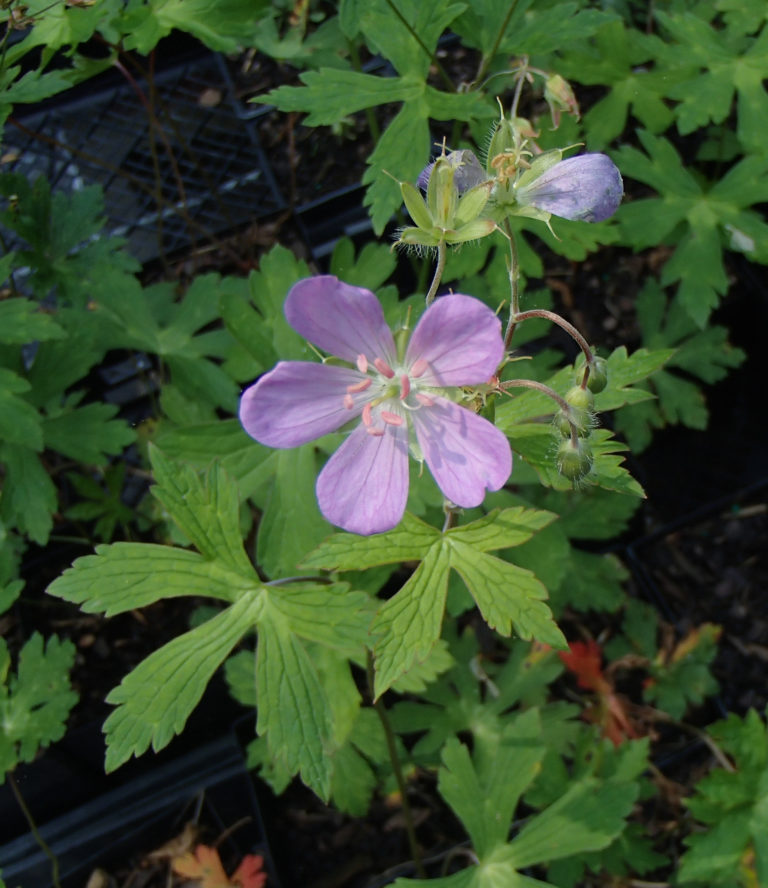Wild Geraniums are beautiful wild flowers of Eastern North America, reported to occur mostly in mountain and piedmont counties of the Carolinas. The plant is a clump-forming mound about 2 feet high, with generous, deeply lobed foliage topped by delicate, 5-petaled, upward-facing, pink flowers in late spring/early summer. Easy to grow in sunny, well watered locations or in part shade, Wild Geranium is a wonderfull plant for adding lush foliage and sweet color, as an individual specimin or in a natralized garden. It will slowly spread by rhizomes, as well as by seeds which are projected vigorously away from the mother plant when ripe. Wild Geranium attracts bees and butterflies to its nectar, and the foliage is also and important host for several species of moths.
NURSERY HOURS
Wednesday: 10-4 Thursday: 10-6 Friday-Saturday: 10-4 Sunday: 12-4
Geranium maculatum

Key Info
Scientific Name: Geranium maculatum L.
Common Names: Spotted Geranium, Wild Geranium, Wood Geranium, Cranesbill, Alum Root, Alum Bloom and Old Maid's Nightcap.
Family Names: Geraniaceae (Geranium Family)
Plant Type: Herbaceous perennial
Flower Color: Bright lavender pink
Additional Info
Habit: An upright, clump-forming herbaceous perennial about 2 ft tall, with basal leaves and (mostly) unbranched flowering stems arising from the creeping rootstock; spreading slowly by thick, highly branched rhizomes as well as by seed.
Height: 2'
Spread: 1.5'
Soil Conditions: Moist to medium, acidic, rich, humusy soils; tolerates poor soils if moisture rquirement is met.
Leaves: Leaves arising from the root stock are 4-5 inches across, supported by petioles up to 12" long. They are palmately cleft with 5 deep lobes, the leaf margins having in turn a few secondary lobes and coarse teeth. In addition to these, each flowering stem has a pair of opposite leaves, similar in appearance but smaller than the basal leaves, usually with only 3 radial lobes.
Flowers (or reproductive structures: Flowers are 1.0–1.5 in. in diameter, with five rounded, rose-purple-pink petals, 5 green sepals, ten stamens with yellow anthers and a 5-carpeled pistil. Petals show radiating veins which serve as nectar guides (Illinoiswildflowers.info). Flowers grow in loose corymbs or umbels of one to five at the top of the flowering stems.
Fruit: Three-four weeks after flowering, the pistil of the flower develops into a distinctive, beaked, seed capsule ("Crane's Bill"). The 5 slender carpels of this fruit curl upward and backward to fling the ripened seeds from the mother plant, ensuring reproduction at some distance (Illinois Wildflowers).
Natural Distribution: Woods, wood edges, meadows, thickets and shaded roadside areas.
USDA Hardiness Zone: 3 to 8
USDA Wetland Indicator Status in NC: FACU
Pollination: Bees, butterflies, and other insects
Wildlife Connections: The nectar and pollen of the flowers attract many bees, flies, skippers and butterflies. Beetles, bugs, and moth caterpillars feed on the foliage, as well as chipmunks and deer.
Propagation: By seed or by division in early fall.
